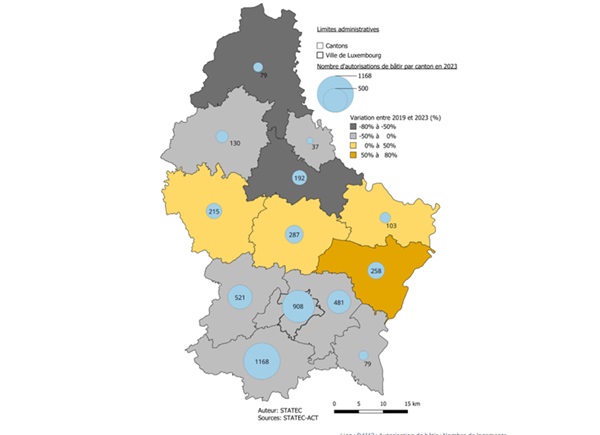 Fewer construction projects are taking place in the northern and southern areas of the Redange, Mersch, Echternach, and Grevenmacher cantons.;
Credit: STATEC/STATEC-ACT
Fewer construction projects are taking place in the northern and southern areas of the Redange, Mersch, Echternach, and Grevenmacher cantons.;
Credit: STATEC/STATEC-ACT
According to Leila Deshayes in a report for STATEC, in 2023, authorised surface areas and housing continued to decline, continuing the trend observed the previous year; building authorisations thus confirmed a persistent decline in activity in the construction sector.
Since 2019, the authorised surface area has decreased from almost 2 million m2 to 1.1 million m2 in 2023, a drop of 44%, with a sharp deterioration since the start of the war in Ukraine in 2022.
Residential and non-residential affected by the economic situation
To provide a more in-depth perspective, it is possible to distinguish between residential and non-residential construction types. According to STATEC, a decline was observed in both sectors. In 2019, residential building authorisations amounted to 1 million m2, but this figure dropped to 609,000 m2 in 2023, representing a decrease of 41%. In the non-residential area, five years ago, authorised requests corresponded to a construction area of around 920,000 m2, while they were struggling to reach 510,000 m2 in 2023 (i.e. a drop of 44%).
In the residential sector, with just over 4,450 authorised housing units, Luxembourg reached a level similar to 2015, but at that time it had almost 560,000 inhabitants compared to more than 660,000 on 1 January 2023.
A more marked slowdown in single-family homes
In 2023, one in four authorised dwellings concerns a single-family house, the rest concerns buildings with two or more dwellings. This distribution has been fairly stable over the last five years, where it was 27% and 73% respectively in 2019.
Last year, just over 1,000 single-family houses were authorised for construction, i.e. down 28% compared to 2019, representing 400 fewer single-family houses. As for buildings with two or more dwellings, almost 3,200 dwellings have been authorised for the year 2023, a somewhat smaller drop of 18%. This decrease represents almost 700 fewer housing units compared to 2019.
A national decline, but with contrasts
At the national level, there is a 5% drop in the number of authorised housing units compared to 2022, a year which was already at a lower level compared to previous years. Compared with the five previous years, STATEC observed a drop of 20%.
However, an in-depth analysis revealed divergent dynamics depending on the geographic areas. In comparison with the previous year, Luxembourg City and the canton of Esch-sur-Alzette showed notable positive developments, recording increases of 18% (an additional 140 housing units) and 32% (280 more housing units), respectively.
However, this improvement masks a more nuanced reality, because their trajectory compared to 2019 remains negative, with respective drops of 12% for the capital and 17% for the canton of Esch-sur-Alzette, Leila Deshayes added. The other cantons of the country are experiencing a downward trend compared to 2022, STATEC emphasised.
Upon studying the percentage change compared to 2022, the Western cantons showed the strongest growth, reaching -32%. However, according to Leila Deshayes, it is essential to contextualise this decrease, because the year 2022 was exceptional for these cantons with nearly 1,100 authorised housing units. Thus, the level reached in 2023 remained relatively similar to that of 2019 (770 housing units), with a moderate reduction of only 350 housing units.
The geographical areas are defined as follows:
- Central cantons: Luxembourg-Countryside, Mersch;
- Southern canton: Esch-sur-Alzette;
- Northern cantons: Clervaux, Diekirch, Vianden and Wiltz;
- Western canton: Capellen, Redange;
- Eastern cantons: Echternach, Grevenmacher and Remich.
The map provided as an illustration by canton allow a better visualisation of the development taking place between 2019 and 2023. The reduction in the number of housing units to be built is visualised, spread over a large part of the Grand Duchy, apart from the cantons of Redange, Mersch, Echternach and Grevenmacher.








